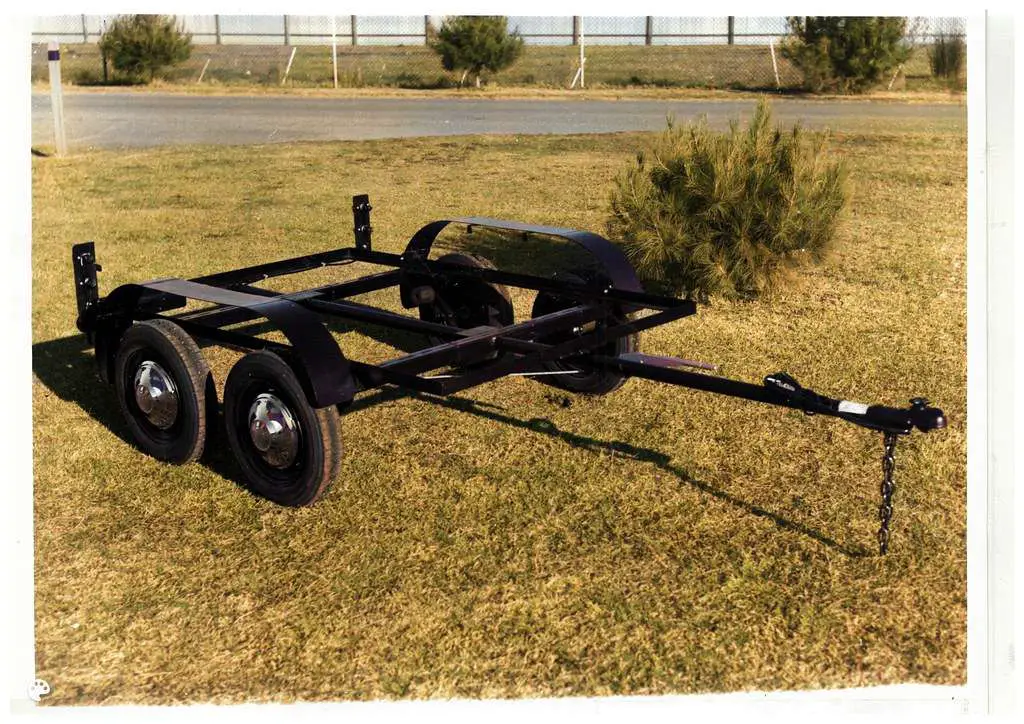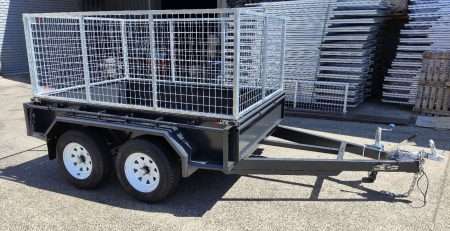
Rev Up Your Hauling Game: Exploring Tandem Trailer Sales
Tandem Trailers: An Overview
When it comes to hauling large and heavy loads, tandem trailers are a popular choice. In this section, we will provide an overview of tandem trailers, including what they are and the benefits they offer.
What Are Tandem Trailers?
Tandem trailers, also known as tandem axle trailers or dual axle trailers, are designed with two axles placed closely together. These axles work in tandem to support the weight of the cargo being transported. Tandem trailers are commonly used for various applications, including utility trailers, boat trailers, dump trailers, flatbed trailers, enclosed trailers, car trailers, and cargo trailers.
The presence of two axles allows the weight of the load to be distributed more evenly, providing better stability and control during towing. This distribution of weight helps to minimise the risk of swaying and fish-tailing, ensuring a smoother and safer towing experience. Tandem trailers are especially advantageous when hauling heavy loads, as they offer higher weight capacities compared to single-axle trailers.
Benefits of Tandem Trailers
Tandem trailers offer several benefits that make them a preferred choice for many hauling needs. Let’s explore some of the key advantages of using tandem trailers:
1. Weight Capacity and Load Distribution
One of the primary advantages of tandem trailers is their higher weight capacity. With two axles supporting the load, tandem trailers are capable of carrying heavier cargo compared to single-axle trailers. The weight is distributed more evenly across the axles, reducing the strain on each axle and enhancing overall load-bearing capacity.
2. Stability and Control
Tandem trailers provide enhanced stability and control during towing. The two axles work in tandem to resist sway and provide better handling on the road. This stability is particularly important when travelling at higher speeds or navigating challenging terrains. Additionally, tandem trailers are equipped with brakes on both axles, resulting in improved braking performance and enhanced safety while towing.
3. Durability and Longevity
Due to their robust construction and design, tandem trailers are known for their durability and longevity. The additional axle and reinforced frame contribute to the strength and structural integrity of the trailer, enabling it to withstand heavy loads and rough conditions. Tandem trailers are built to last, making them a reliable choice for frequent transportation needs.
When considering the purchase of a tandem trailer, it’s important to factor in specific needs and budget as well as maintenance and care requirements. By carefully evaluating these considerations, individuals can select a tandem trailer that best suits their hauling requirements while ensuring long-term satisfaction and performance.
As the utility trailer market continues to grow globally, tandem trailers play a significant role in meeting the diverse needs of businesses and individuals. To learn more about market trends and segmentation within the utility trailer industry, continue reading our article on tandem trailers in the utility trailer market.
Tandem Trailers vs. Single-Axle Trailers
When it comes to choosing the right trailer for your hauling needs, understanding the differences between tandem trailers and single-axle trailers is crucial. Tandem trailers, also known as dual axle trailers, offer several advantages over their single axle counterparts in terms of weight capacity, load distribution, stability, and control.
Weight Capacity and Load Distribution
Tandem trailers have a higher weight capacity compared to single-axle trailers, making them suitable for hauling heavier loads. The presence of two axles allows the weight of the load to be distributed more evenly, reducing strain on each individual axle. This balanced weight distribution minimises the risk of overloading and improves the overall towing experience. Tandem trailers are commonly used for hauling construction equipment, livestock, and other heavy loads that require a higher weight capacity (TP Trailers Inc.).
The weight distribution on tandem trailers also contributes to better handling and stability. With two axles, the load is spread over a larger surface area, making it easier to transport heavy loads without compromising stability. This even weight distribution ensures that the trailer remains steady and balanced, reducing the risk of swaying or fishtailing during towing (Medium).
Stability and Control
Tandem trailers offer increased stability and better handling compared to single-axle trailers. The presence of two axles creates four points of contact with the ground, resulting in improved traction and control. This enhanced stability is particularly beneficial when towing on uneven or rough terrain, as it helps to minimise trailer sway and maintain a smoother towing experience. Tandem trailers are equipped with brakes on both axles, providing better stopping power and control and further enhancing safety while towing (TP Trailers Inc.).
The increased stability and control of tandem trailers make them an ideal choice for various applications, ranging from transporting heavy machinery to hauling cargo for businesses or recreational purposes. Whether it’s for construction, landscaping, or recreational activities, tandem trailers offer the reliability and performance needed to tackle diverse hauling tasks with confidence.
By opting for a tandem trailer, you can take advantage of its higher weight capacity, improved load distribution, and enhanced stability. These benefits make tandem trailers a popular choice for those who require a reliable and durable transportation solution for their heavy hauling needs. Before making a purchase, consider your specific requirements, budget, and maintenance needs to ensure that you select the right tandem trailer for your hauling demands.
Why Choose a Tandem Trailer
When it comes to hauling heavy loads, tandem trailers are a popular choice for many. They offer several advantages over single-axle trailers, including enhanced safety features, durability, and longevity.
Enhanced Safety Features
One of the key reasons to choose a tandem trailer is the improved safety it provides. Tandem axle trailers, with their two axles, distribute the weight of the load more evenly, reducing the strain on each axle. This distribution helps to enhance stability and control while towing, particularly on uneven or challenging terrains. Compared to single-axle trailers, tandem trailers are less prone to swaying and fish-tailing, providing a smoother and safer towing experience (PJ Trailers). Additionally, tandem trailers are equipped with brakes on both axles, providing better stopping power and control when needed, ensuring a safer towing experience (TP Trailers Inc.).
Durability and Longevity
Tandem trailers are built to withstand the demands of heavy-duty hauling. They offer increased durability and longevity compared to single-axle trailers, making them a worthwhile investment for those with frequent towing needs. The presence of two axles helps distribute the weight more evenly, reducing strain on individual components. This design, coupled with sturdy construction, ensures that tandem trailers can handle heavier loads and endure the rigours of various hauling applications. While tandem trailers may come with a higher price tag than single-axle trailers, their durability and longevity make them a cost-effective choice in the long run (PJ Trailers).
By opting for a tandem trailer, you can enjoy the peace of mind that comes with enhanced safety features and the assurance of a long-lasting hauling solution. Whether you’re transporting construction equipment, livestock, or other heavy loads, tandem trailers provide the stability, control, and durability needed for a successful haul.
The Utility Trailer Market
The utility trailer market plays a crucial role in various industries, offering versatile transportation solutions for a wide range of applications. Let’s explore the global market size, growth, and segmentation of utility trailers.
Global Market Size and Growth
According to Industry Research Biz, the global utility trailers market was valued at USD 23,325.56 million in 2022. It is projected to reach USD 29,502.94 million by 2031, with a compound annual growth rate (CAGR) of 3.99% during the forecast period. This growth can be attributed to the increasing demand for efficient and reliable transportation solutions across various industries.
The utility trailer market’s growth is influenced by several factors, including population growth, industrial development, and economic factors. For instance, the Asia-Pacific region, particularly China, is expected to witness significant growth in the utility trailers market due to population growth, increasing disposable income, and a favourable economic climate.
However, it is important to note that the utility trailer market, like many other industries, experienced disruptions and challenges during the COVID-19 pandemic. Supply chain disruptions and fluctuations in demand impacted the growth potential of the market. Nevertheless, as economies recover and industries rebound, the utility trailer market is expected to regain momentum and continue its growth trajectory.
Segmentation by Application and Type
The utility trailer market is segmented based on both application and type. Understanding these segments helps cater to specific transportation needs across different industries.
Segmentation by Application
The utility trailer market serves various applications, including:
- Individual: Utility trailers are commonly used by individuals for personal transportation needs, such as moving furniture, hauling recreational equipment, or transporting goods.
- Rental Fleet: Rental companies offer utility trailers for short-term use, catering to individuals or businesses in need of temporary transportation solutions.
- Construction: Utility trailers play a vital role in the construction industry, facilitating the transportation of construction equipment, materials, and waste.
- Industrial: Industries such as manufacturing, logistics, and agriculture rely on utility trailers for efficient transportation of goods, raw materials, and machinery.
- Others: Utility trailers find applications in diverse industries and sectors, providing customised transportation solutions for unique needs.
Segmentation by Type
The utility trailer market is further segmented based on the type of trailers, including:
- Single Axle: Single axle trailers consist of one axle and are suitable for lighter loads and smaller towing vehicles.
- Tandem Axle: Tandem axle trailers, also known as dual axle trailers, feature two axles and offer increased weight capacity and stability compared to single axle trailers.
- Three or More Than Three Axles: Trailers with three or more axles are designed for heavy-duty applications, capable of carrying large loads and providing enhanced stability.
These segments cater to different hauling requirements, allowing customers to choose the appropriate utility trailer based on their specific needs.
As the utility trailer market continues to grow, manufacturers are constantly innovating and introducing new features and technologies to enhance trailer performance, durability, and efficiency. Understanding the market’s size, growth, and segmentation can help consumers make informed decisions when considering tandem trailer sales or exploring other utility trailer options.
Emerging Trends in Tandem Trailers
As the demand for efficient and adaptable transportation solutions continues to grow, the tandem trailer industry is witnessing several emerging trends. These trends are driven by advancements in technology, changing customer needs, and the push for sustainability. In this section, we will explore two significant trends: e-commerce and customisation, as well as autonomous technology and electric options.
E-commerce and customisation
The rise of e-commerce has significantly impacted the logistics and transportation industry. With the increasing demand for faster and more flexible delivery options, e-commerce companies are seeking customised solutions to meet their evolving needs, particularly during busy and unpredictable peaks (MPofCinci). This demand has led to the development of fleets with smaller-sized trucks and customised trailers that can be tailored to specific requirements.
Customisation options for tandem trailers include adjustable shelving, dividers, and cargo restraint systems. These features allow for efficient organisation and secure transportation of various goods. Additionally, trailers can be equipped with advanced technology, such as telematics systems, to provide real-time tracking and monitoring of cargo. This level of customisation ensures that businesses can optimise their operations and adapt to changing market demands.
Autonomous Technology and Electric Options
The integration of autonomous technology in the transportation industry is revolutionising the way goods are delivered. Autonomous truck and trailer combinations are being developed to streamline and enhance distribution methods. These advanced systems utilise technologies such as ultrasonic sensors, radar, and lidar-equipped vehicles, which can be controlled through a cell phone app (MPofCinci). By leveraging these technologies, companies aim to improve efficiency, reduce operating costs, and enhance safety on the roads.
In addition to autonomous technology, the shift towards electric options is gaining momentum in the tandem trailer market. Electric tractor-trailers offer the potential for significant fuel savings and reduced environmental impact. Major companies like Walmart have already preordered fleets of electric tractor-trailers, with estimated fuel cost savings of $25,000 per vehicle (MPofCinci). However, it’s important to note that electric vehicles currently have limited range, typically around 500 miles on a single charge. As battery technology improves, the range and capabilities of electric tandem trailers are expected to increase.
These emerging trends in tandem trailers highlight the industry’s commitment to innovation and sustainability. By embracing e-commerce and customisation, businesses can adapt to changing customer demands and optimise their operations. Similarly, the integration of autonomous technology and electric options paves the way for more efficient and eco-friendly transportation solutions. As the market continues to evolve, tandem trailer manufacturers are expected to incorporate the latest technologies to enhance performance, safety, and overall efficiency (MPofCinci).
Considerations for Buying a Tandem Trailer
Before purchasing a tandem trailer, it is essential to consider specific needs and budgets, as well as maintenance and care requirements. These factors will help ensure that the chosen trailer meets your hauling requirements and remains in good condition for years to come.
Specific Needs and Budget
When selecting a tandem trailer, it’s crucial to evaluate your specific hauling needs. Consider the types of loads you will be transporting, their weight, and any specialised requirements. Tandem trailers are commonly used for hauling construction equipment, livestock, and other heavy loads (TP Trailers Inc.). Assessing your specific needs will help determine the appropriate size, weight capacity, and features required for your hauling tasks.
Another important consideration is your budget. Tandem trailers offer increased capacity and stability compared to single-axle trailers, but they may come at a higher cost (Medium). Determine a realistic budget range and explore options within that range. It’s important to strike a balance between affordability and desired features to ensure you get the best value for your investment.
Maintenance and Care
Proper maintenance and care are essential for keeping your tandem trailer in optimal condition and extending its lifespan. Regular maintenance tasks may include inspecting the trailer’s tyres, brakes, lights, and electrical systems, as well as lubricating moving parts and checking for any signs of wear or damage. Following the manufacturer’s guidelines for maintenance and care is crucial to ensuring the trailer remains in safe and reliable working condition.
In addition to routine maintenance, proper care during use is important. Avoid overloading the trailer beyond its weight capacity, as this can put excessive strain on the trailer’s components and compromise its structural integrity. When towing, ensure that the load is properly secured and evenly distributed to maintain balance and stability.
To protect the trailer from rust and corrosion, especially if it is exposed to harsh environmental conditions, consider opting for a galvanised tandem trailer. Galvanised trailers feature a protective zinc coating that helps prevent rust and extends the trailer’s lifespan.
Regularly inspect the trailer for any signs of damage or wear, such as cracks, dents, or loose components. Promptly address any issues to prevent further damage and ensure safe operation.
By considering your specific needs and budget, as well as implementing proper maintenance and care practices, you can make an informed decision when purchasing a tandem trailer. This will help you choose a trailer that meets your hauling requirements, provides durability and longevity, and ensures safe and reliable transportation of your valuable cargo.
The Future of Tandem Trailers
As the demand for transportation and logistics continues to grow, the future of tandem trailers looks promising. Tandem trailers are expected to play a significant role in the market, thanks to their versatility and ability to handle heavy loads. In this section, we will explore the projected market growth of tandem trailers and the technological advancements and challenges that lie ahead.
Projected Market Growth
The global trailer market is projected to reach a value of $52.10 billion by 2027, growing at a CAGR of 5.3% during the forecast period from 2020 to 2027. The truck trailers market is also expected to witness substantial growth, with a projected value of USD 105 billion by 2030 and a CAGR of 7.02% during the forecast period from 2022 to 2030.
The increasing demand for tandem trailers is driven by the rising number of small businesses and building projects worldwide, as well as the need for efficient transportation solutions. Tandem trailers offer high load capacity and improved stability, making them ideal for various applications, such as cargo transportation, construction, and agriculture.
Technological Advancements and Challenges
Technological advancements are poised to revolutionise the tandem trailer industry. One of the significant trends is the integration of advanced telematics systems, which enable real-time tracking and monitoring of trailers. These systems provide valuable data on trailer location, condition, and performance, allowing for efficient fleet management and improved logistics.
The adoption of Internet of Things (IoT) devices is another technological advancement in tandem trailers. These devices can be used for predictive maintenance, helping to identify potential issues before they lead to breakdowns or accidents. IoT devices also enable remote diagnostics and data-driven decision-making, enhancing overall performance and reducing downtime.
However, along with the opportunities brought by technological advancements, there are also challenges to overcome. Rising material costs, particularly for steel and aluminium, which are primary materials for tandem trailer manufacturing, can impact the profit margins of manufacturers and buyers. Supply chain disruptions caused by events like the COVID-19 pandemic can further complicate the production and delivery of tandem trailers.
In addition, the industry faces the challenge of meeting evolving regulations and sustainability requirements. Tandem trailer manufacturers are increasingly focusing on eco-friendly practices, such as the adoption of electric and hybrid semi-trailers, to reduce emissions and operating costs. Governments and regulatory bodies are providing incentives and subsidies to encourage the transition to environmentally friendly transportation options.
Overall, the future of tandem trailers looks promising, with projected market growth and significant technological advancements. As the demand for efficient transportation solutions continues to rise, tandem trailers will play a crucial role in meeting the evolving needs of various industries. By embracing technological innovations and addressing challenges, manufacturers can continue to enhance the performance, safety, and sustainability of tandem trailers, ensuring a bright future for the industry.
Author
I am Rahatul Ashiq Tamal. Another author of Muscle Trailers. Muscle Trailers is a well-known trailer brand in Sydney, Melbourne & Adelaide

How to Mount a Spare Tire on Your Trailer: A Simple Step-by-Step Guide
Trailer service centers receive over 1 million phone calls and 1.3 million emails each year about trailer maintenance problems....

How to Fix RV Roof Leaks: Simple Roof Leak Detection Guide for Beginners
Did you know DIY RV roof repairs can cost under $50? But undetected leaks could lead to substantially higher repair...

Starting a Food Truck Business in Australia: From Trailer Selection to Launch
The Australian mobile food market has evolved into a billion-dollar industry. This makes a food truck...
